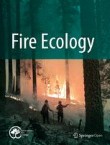Fire Ecology is the official journal of the Association for Fire Ecology.
An analysis of the recent fire regimes in the Angolan catchment of the Okavango Delta, Central Africa
This paper presents an analysis of fire regimes in the poorly studied Angolan catchment of the Okavango Delta in Botswana. We used MODIS data to examine the frequency and seasonality of fires over 20 years (fr...
